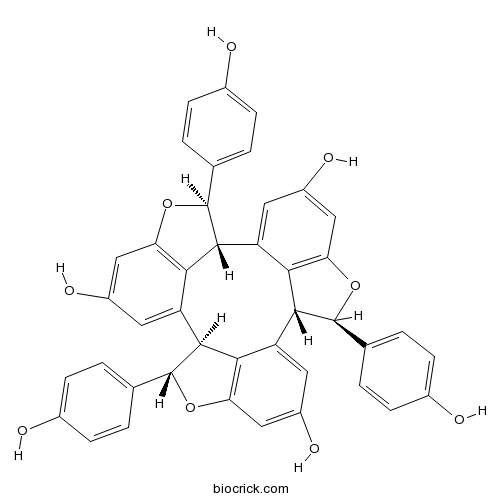A nine-membered macrocycle that incorporates three 6-hydroxy-2-(4-hydroxyphenyl)-2,3-dihydro-1-benzofuranyl moieties as part of the cyclic skeleton. It is isolated from Caragana chamlague Lamarck and exhibits significant inhibitory effect towards the enzyme acetylcholinesterase (EC 3.1.1.7).
Alpha-viniferin isolated from Caragana chamlagu is a trimer of resveratrol, has anti-inflammatory, anti-oxidant, anti-arthritis, and anti-tumor activities;alpha-viniferin strongly inhibits 7 of the 9 CYP isoforms (except CYP2A6 and CYP2E1); alpha-viniferin strongly inhibits CYP2C19-mediated omeprazole 5-hydroxylation and CYP3A4-catalyzed midazolam 1-hydroxylation with IC 50 values of 0.93 and 1.2μM, respectively.[1]
(+)-Alpha-viniferin, a stilbene trimer from Caragana chamlague, inhibits acetylcholine
-sterase (AChE) activity in a dose-dependent manner, the IC50 value is 2.0 microM.[2]
Alpha-viniferin at doses> 30 mg/kg(p. o.) or > 3 mg/kg (i. v.)shows significant anti-inflammatory activity through inhibition of cyclooxygenase-2 and inducible nitric oxide synthase on carrageenin-induced paw edema in mice; alpha-Viniferin showed an inhibitory effect with an IC(50) value of 4.9 microM on COX-2 activity, but a very weak inhibitory effect at 100 microM on COX-1 activity; alpha-Viniferin inhibited synthesis of iNOS transcript with an IC50 value of 4.7 microM.[3]
Alpha-viniferin is a prostaglandin H2 synthase inhibitor, the inhibitory potency of (+)-alpha-viniferin is about 3- to 4-fold stronger than that of resveratrol on cyclooxygenase activity of prostaglandin H2 synthase partially purified from sheep seminal vesicles.[4]
English website: alpha-Viniferin
Japanese website: alpha-Viniferin
Chinese website: alpha-Viniferin
[1] Sim J, Jang H W, Min S, et al. Food Chem Toxicol , 2014, 69:276-80.
[2] Sung S H, Kang S Y, Lee K Y, et al. Biol Pharm Bull, 2002, 25(1):125-7.
[3] Chung E Y, Kim B H, Lee M K, et al. Planta Med, 2003, 69(8):710-4.
[4] Lee S H, Shin N H, Kang S H, et al. Planta Med, 1998, 64(3):204-7.
[5] Shu N, Zhou H, Hu C. Biol Pharm Bull, 2006, 29(4):608-12.



